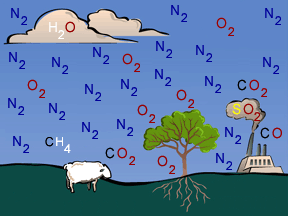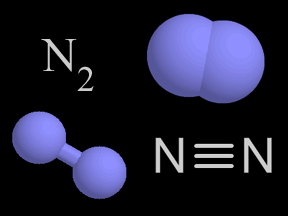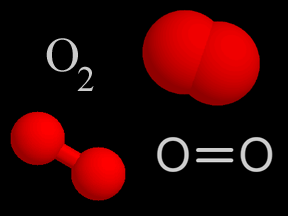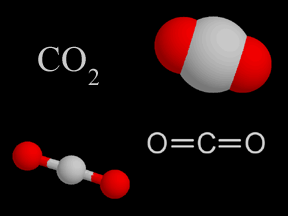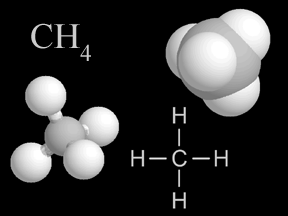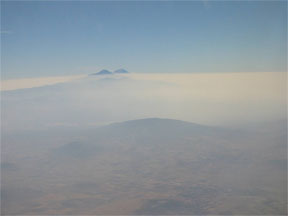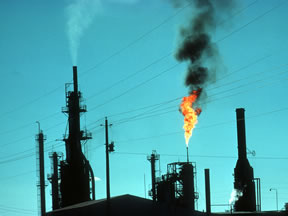Click on image for full size
Image courtesy UCAR, modified by Windows to the Universe staff (Randy Russell).
Atmospheric Chemistry of Earth's Troposphere
When you think of chemistry, do you think about mixing colored liquids in test tubes and maybe making an explosion... or at least a nice puff of smoke? Did you know that a lot of chemistry happens in Earth's atmosphere? There are many different kinds of chemicals in the air. Those chemicals often combine with each other in chemical reactions, making new and different chemicals. This is called "atmospheric chemistry".
Earth's atmosphere has different layers. The lowest layer is called the troposphere. We live in the troposphere. This page explains about atmospheric chemistry in the troposphere.
Most of the gas in our atmosphere is nitrogen. About 4/5ths of the air is nitrogen. What about the other 1/5th? Almost all of it is oxygen, the stuff in the air we need to breathe. There are also very small amounts of a bunch of other chemicals.
Have you heard of greenhouse gases? They are kinds of gases that trap the heat from sunlight in our atmosphere. Earth would be very cold if we didn't have any greenhouse gases. Carbon dioxide and methane are two very important greenhouse gases.
Some of the chemicals in the air come from pollution. When we burn coal in a factory or gasoline in our cars, we make air pollution. Coal and oil have sulfur in them. When they burn, they make chemicals called sulfur oxides. These can turn into sulfuric acid when they mix with water droplets in the air. These droplets of acid can fall to the ground as acid rain. Cars and trucks also give off chemicals called nitrogen oxides. Nitrogen oxides combine with other chemicals to make smog. They also help make nitric acid, which is another acid in acid rain.
Nature also does things to change the chemistry of the troposphere. Volcanoes, lightning, and wildfires all add chemicals to the air or change the ones that are already there. Energy from sunlight can make chemical reactions happen, changing one gas into another. Some chemicals move in cycles between the atmosphere, living creatures, and the oceans. The Carbon Cycle and the Nitrogen Cycles are two important cycles that change the chemistry of the atmosphere.
This table (below) describes some of the chemicals in the troposphere, and some of the chemical reactions that happen in the air:
| Chemical | Formula | Role in Tropospheric Chemistry |
| Carbon dioxide | CO2 |
Carbon dioxide is a kind of greenhouse gas. When we breathe, we take in oxygen and breathe out carbon dioxide. Plants and some kinds of microbes use carbon dioxide during photosynthesis to make food. Burning fuels also puts carbon dioxide into the atmosphere. |
| Carbon monoxide | CO |
When things burn, they mostly make carbon dioxide. Sometimes they make carbon monoxide, too. Carbon monoxide is a poisonous gas. Volcanoes and car engines make carbon monoxide. |
| Hydrocarbons | CxOy |
Hydrocarbons are chemicals made up of hydrogen and carbon atoms. When fuel burns, it puts some hydrocarbons into the air. Hydrocarbons help to make smog, a kind of air pollution. |
| Methane | CH4 |
Methane is a kind of greenhouse gas. |
| Nitrogen | N2 |
Most of the gas in Earth's atmosphere is nitrogen. About 4/5ths of the air is nitrogen. The nitrogen cycle explains how nitrogen moves around in the environment. When fuel burns hot, like it does in the engine of a car, nitrogen combines with oxygen to make nitrogen oxides. |
| Nitrogen Oxides | NO & NO2 |
Nitrogen oxides are a kind of pollution. Burning fuels like gasoline in air makes nitrogen oxides. Most nitrogen oxides come from cars and trucks. They help to make smog. They also mix with water droplets in the air to make nitric acid. Nitric acid is a part of acid rain. |
| Nitric Acid | HNO3 |
Nitric acid is part of acid rain. Nitric acid forms when nitrogen oxides mix with water droplets in the air. Nitrogen oxides are a kind of pollution that comes from the engines of cars and trucks. |
| Oxygen & Ozone | O2 & O3 |
About 1/5th of the gas in the atmosphere is oxygen. When you breathe, your body uses the oxygen to keep you alive. Ozone is a special kind of oxygen that has three atoms instead of two. |
| PAN (Peroxyacytyl nitrate) | C2H3O5N |
PAN is a kind of air pollution. Smog has PAN in it. PAN forms when nitrogen dioxide, oxygen, and Volatile Organic Compounds (VOCs) get together. |
| Smog | - |
Smog is a mixture of smoke and fog. Photochemical smog is a kind of air pollution. It has nitrogen oxides, ozone, VOCs, and PAN in it. |
| Photodissociation | - |
|
| Sulfur Oxides | SO2 & SO3 |
Sulfur dioxide and sulfur trioxide are types of pollution. People make them when we burn coal and oil. Volcanoes also give off sulfur oxides. Sulfur dioxide mixes with water droplets in the air to make sulfuric acid. Sulfuric acid is in acid rain. |
| Sulfuric Acid | H2SO4 |
Sulfuric acid is in acid rain. Sulfuric acid in the air is made when sulfur dioxide gas mixes with water droplets. The sulfur dioxide gas comes from volcanoes and from coal and oil that people burn for fuel. |


